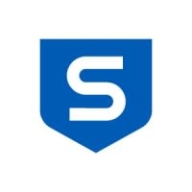


Sophos XG and Check Point NGFW both compete in the network security category, focusing on providing robust protection for enterprises. Check Point NGFW holds an advantage in terms of advanced threat prevention and management flexibility, making it highly suitable for complex environments.
Features: Sophos XG is recognized for its ease of use, scalability, and strong security features. It enhances network security with synchronized security, VPN, and firewall protection, allowing seamless integration into high-security frameworks. Check Point NGFW offers advanced threat prevention, application control, and centralized management. Users benefit from its flexibility and granular policy management, which focus on threat prevention and integration with various platforms.
Room for Improvement: Improvements for Sophos XG include scalability and enhancements to security features and VPN functionality, as well as more intuitive support and administration interfaces. Check Point NGFW can be challenging to manage and set up due to its complexity. Its high initial costs and difficulties with third-party integration and documentation are notable areas for improvement.
Ease of Deployment and Customer Service: Sophos XG generally has a straightforward on-premises and cloud setup with good documentation and community support, though its technical support can vary in quality and response time. Check Point NGFW often requires professional assistance for initial setup due to its complexity. Its customer service experiences vary, with some users experiencing efficient service while others face long wait times.
Pricing and ROI: Sophos XG is seen as reasonably priced, offering good value by integrating multiple security features into a single solution. It provides a middle-ground cost-effectiveness compared to Palo Alto and FortiGate, delivering good ROI. In contrast, Check Point NGFW is viewed as a more costly option, justified by its comprehensive security offerings, though its licensing complexity can impact perceived value compared to more budget-friendly alternatives.
Clients are now comfortable and not wasting productive hours on IT support.
We have experienced a positive return on investment by utilizing Fortinet's products.
There's definitely an ROI. Having a centralized way of managing and applying policies across the entire organization always helps.
This is a time-saving measure because we don't need to deploy a cluster or a firewall each time; we just create a virtual system on the management server using the same appliance.
It's good, but I would still say it's higher by about 10-15 percent compared to other market products with similar configurations.
Having a Unified Threat Management system like Sophos XG has helped us spend less on network security, thus providing a good return on investment by managing our income effectively.
My customers see a return on investment and value for money with Sophos XG.
He explained that it required a command line configuration, as it couldn't be done through the graphical user interface.
I would rate their support for FortiGate a nine out of ten.
They offer very accurate solutions.
The support team we engaged was knowledgeable and well-versed with the application.
We have escalated issues to Check Point technical support multiple times and have received timely and very good responses.
Even challenging issues like those with VPNs have been resolved efficiently with their help.
Users are reluctant to open support cases and would rather reinstall an appliance themselves than go through the support process.
I would rate the technical support a nine out of ten.
Microsoft's protection has received positive feedback and strong on-site support from both customers and partners.
They scale up really well from smaller models like the FortiGate 40 and 50 to bigger sites with the FortiGate 100 for more throughput - up to enterprise datacenters.
The variation comes in terms of the interfaces and throughputs, but from a security perspective, you get the same benefit, irrespective of whether you have an entry-level unit or an enterprise.
You can choose a cheaper model if you only have 20-30 users, but you will need to spend more money for a FortiGate solution that covers 5,000.
If specified correctly, even the smaller boxes offer high session and bandwidth rates, making the solution highly scalable, even up to telco-level requirements.
Scalability must be carefully planned for, considering future growth and user base increases.
They offer multiple solutions from SMBs to enterprise data centers, making it an easily scalable solution with no issues in scalability.
You can scale up to multiple firewalls with centralized management.
You can't upgrade memory or storage on a specific model, which limits scalability.
The scalability of the solution is limited to three nodes and may not be sufficient for extensive scaling.
Improper handling of these can lead to a memory surge, a well-known bug that can cause the entire system to freeze.
It is less stable than Palo Alto Networks and Check Point firewalls because there are lots of bugs in the latest firmware.
We have not had any problems with the operating systems or maintenance of subscriptions.
While the solution is generally stable, there are complications, such as requiring SmartConsole for deployment and upgrades, which can be time-consuming.
I have worked with Check Point products for 15 years and haven't found any stability or performance issues.
I have encountered stability issues primarily with VPN, which required a code upgrade.
I would rate the stability of Sophos XG a ten out of ten.
Sophos XG is very stable, even when serving as a DHCP server.
Sophos XG is resource-greedy, affecting performance even on newer computers.
If I have put 10 GBPS of throughput on a firewall and I enable all of these features available, such as IPS or UTM functionalities, the throughput comes down to 1 GBPS.
By providing an integrated solution, users would have access to all features and functionalities within a single window, eliminating the need to navigate through multiple windows.
Investing in a solution that can accommodate such growth would be more cost-effective than repeatedly purchasing new hardware.
Other products, like FortiGate, are perceived as more intuitive because they are easier to configure from the start.
Check Point would benefit from having a single console for both basic and policy configurations.
The graphical user interface (GUI) could benefit from some updates.
The solution should have the ability to be up to date with the most recent threats.
This suggests a vulnerability that needs addressing to ensure administrators can update patches without losing access.
Business cannot stop just because of issues with support.
Secure SD-WAN is free of charge.
The most expensive part is the renewal of the license subscription.
FortiGate is priced lower than Palo Alto.
In comparison to Fortinet and other products, the pricing may be considered high.
Compared to other solutions, the pricing of Check Point NGFW is high.
The perception is that Check Point NGFW is expensive, especially when all software modules are included.
I would rate the pricing a ten out of ten as high.
The licensing cost in the final currency amount, is 163,080, with three years of support.
I rate the pricing a ten out of ten.
The firewall, IPS, and VPN functions are the most valuable features.
FortiGate provides solid protection against viruses, malware, and other threats.
Within the same dashboard, you get to see the security profiles, the type of traffic that's passing through, the top applications that are being consumed, etc.
The firewall's default behavior of blocking all traffic, including a cleanup rule that blocks everything from external to internal sources, is highly valuable for protecting our network.
The most valuable features in my experience include perimeter firewalling, cloud and mobile security, application control, URL filtering, DLP, threat prevention, intrusion protection, and safeguarding against malware, botnets, and zero-day attacks.
In the normal GA login, I can create interfaces and configure interface IPs, while in the SmartConsole, I manage the NAT quality and firewall access.
This unique technology provides efficient branch connectivity without the need to invest in additional firewalls for each branch.
I particularly like the visibility it provides into network traffic, allowing us to identify and address issues efficiently.
The firewall feature of Sophos XG has been the most effective for threat prevention.



Fortinet FortiGate offers comprehensive network security and firewall protection across multiple locations. It effectively manages data traffic and secures environments with features like VPN, intrusion prevention, and UTM controls.
Organizations rely on Fortinet FortiGate for its robust integration with advanced security policies, ensuring significant protection for enterprises, cloud environments, and educational sectors. It facilitates network segmentation, application-level security, and authentication management, securing communication within and between locations such as branches and data centers. Its efficient SD-WAN and UTM features enable streamlined data management and enhanced threat protection capabilities. Users appreciate its centralized management, facilitating seamless operations across diverse environments.
What are the key features of Fortinet FortiGate?
What benefits should users expect from Fortinet FortiGate?
Fortinet FortiGate is crucial in sectors like education, offering robust networks for secure data flow between campuses and facilitating remote learning. In enterprise environments, it allows efficient management of application traffic and security across multiple branches, while in the cloud, it seamlessly integrates with diverse platforms to enhance security infrastructure.
Check Point NGFW provides comprehensive firewall protection, managing VPNs, and securing network perimeters with advanced threat prevention techniques. It's widely used to protect businesses, data centers, and ensure secure traffic management.
Check Point NGFW offers robust security for companies, delivering security features like threat prevention, URL filtering, and intrusion prevention across both layer 3 and layer 7. It supports remote access, web filtering, application control, and safeguards against malware, botnets, and zero-day attacks. With its intuitive management console, deep packet inspection, centralized management capabilities, and sophisticated threat detection, Check Point NGFW enhances network security and productivity. The system integrates seamlessly with other technologies and provides real-time monitoring, detailed reporting, and automated policy management. Additionally, its setup is straightforward, it scales well, and offers comprehensive logging.
What are the key features?Check Point NGFW is implemented in industries like finance, healthcare, and retail, where protecting sensitive data and ensuring compliance are critical. Its advanced security features and ease of management make it suitable for large enterprises and data centers, ensuring reliable and secure network operations.
Sophos XG is a versatile network security solution that offers network protection, firewall management, VPN access, web filtering, and intrusion prevention, providing comprehensive security for businesses from small offices to large enterprises.
Sophos XG stands out for its Synchronized Security, easy setup, and robust templates. It manages VPN access, protects against threats, and handles load balancing and traffic monitoring. The cloud-based management, centralized dashboard, and detailed logging make it user-friendly and reliable. Integration of features like email protection, SD-WAN, and unified threat management ensures a broad spectrum of security needs are covered. However, it could benefit from improvements in network security, user portals, technical support, and more scalable SD-WAN features.
What are the key features of Sophos XG?Sophos XG is implemented across industries such as healthcare, education, and finance to secure sensitive data and ensure regulatory compliance. It aids in endpoint protection, application control, load balancing, and traffic monitoring essential for these industries. Enhancing network security, simplifying VPN setup, and integrating adaptive security features remain focal points for businesses.
We monitor all Firewalls reviews to prevent fraudulent reviews and keep review quality high. We do not post reviews by company employees or direct competitors. We validate each review for authenticity via cross-reference with LinkedIn, and personal follow-up with the reviewer when necessary.